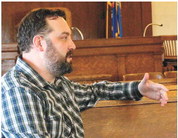Emergency responders take precautions against COVID-19
First responders across Wisconsin are beginning to take extra precautions against the COVID-19 pandemic.
“Our goal would be for the health department to be communicating with dispatch centers to let them know what residences there’s positive COVID-19 patients residing, so that can be flagged, and it immediately pops up for those responding,” said Jerry Biggart, chairman of the Wisconsin Emergency Medical Services Board and Committee, which reports to the Department of Health Services.
“The dispatchers need to screen the patients and ask them questions related to their current signs and symptoms; look for classic symptoms of COVID-19, like fever, trouble breathing, a cough, and communicating that to responders.
Biggart, who is also a fireman in Oak Creek, the city bordering Milwaukee to the south and the hardest impacted area in Wisconsin, has had to deal with the ever-growing virus. He detailed the procedure first responders now go through when tending to a possibly COVID-19 infected person.
“We use the appropriate personal protective equipment (PPE) — our N95 masks, gloves, gown, and eye protection — then once we’re there we further screen the people if possible. If they’re conscious and able to talk to us, we try to stay about six feet away from them. We minimize how many people are actually taking part in patient care, being in a close proximity to them, and try to put a surgical mask on them as soon as possible.”
The classic symptoms of COVID-19 are similar to many other common illnesses, and when described over the phone, Biggart said, it’s extremely difficult to determine if responders need to be extra careful.
“Even a toothache can give you an increased temperature, so there’s no one thing that necessarily jumps out until you’re so close to the patient. Then you’re already in that space where you need to have all of your protective equipment on.”
Biggart explained that not only did their gear and preemptive measures change, but they’ve had to switch up the ways in which responders deliver medical attention.
“Some of our treatments have changed. We are not as aggressive in giving people breathing treatments; we don’t want to increase the amount of particles in the air. We look towards other procedures, rather than things that could increase risk to us.”
Responders don’t just have to think about who they’re going to come in contact with next, but if they had contact with some before, who later tested positive for the disease.
“It’s important that the health department communicates to first responder liaisons that there is a patient that tested positive for COVID-19, and if we had contact with them so we can ensure the level of PPE that the EMS providers and firefighters had on were sufficient.”
Responders have to be on the watch even when responding to a call where there are no reported cases of the novel coronavirus, as they are at danger from being accidentally exposed.
“Somebody who was in a car accident and complaining of some chest pains from the seat belt, no signs they have COVID-19 at all, could get a chest x-ray and doctors see the likelihood of COVID-19 in their lungs, give them a test, and they’re positive,” Biggart continued. “Up to 25 percent of the patients that we have may have no signs or symptoms, so it can be pretty invisible.”
Responders dealing with the virus constantly self monitor to ensure they don’t mistakingly spread the virus to those they are trying to help.
“We are constantly tracking our exposures in case we come down with symptoms, so we can point back to confirmed patients or people under investigation for the virus.”
Overall, the virus is not as aggressive as many believe it to be. Talking from his first-hand experience, Biggart said that it’s likely many people were infected and never even knew it. “We may have had numerous folks already that have been exposed and been through it and are fine. They just thought they had the flu, or something.”
“We do a ton of cleaning, both with disinfecting solutions and ultra-violet light. We’re in a constant state of cleaning and awareness.”
Undeterred by the lingering threat, Biggart said Wisconsin’s first responders will continue to lend aid to those in need, and accomplish their missions to their upmost ability.
“I think the important thing for folks in communities to know is that this is what we do everyday, it’s just different. Anything can happen, and that’s the job we’re in. We plan, we observe, we react, and we overcome.”




